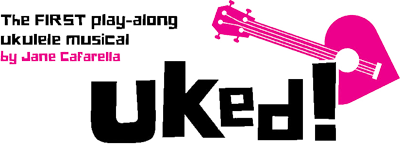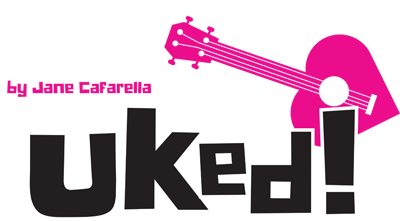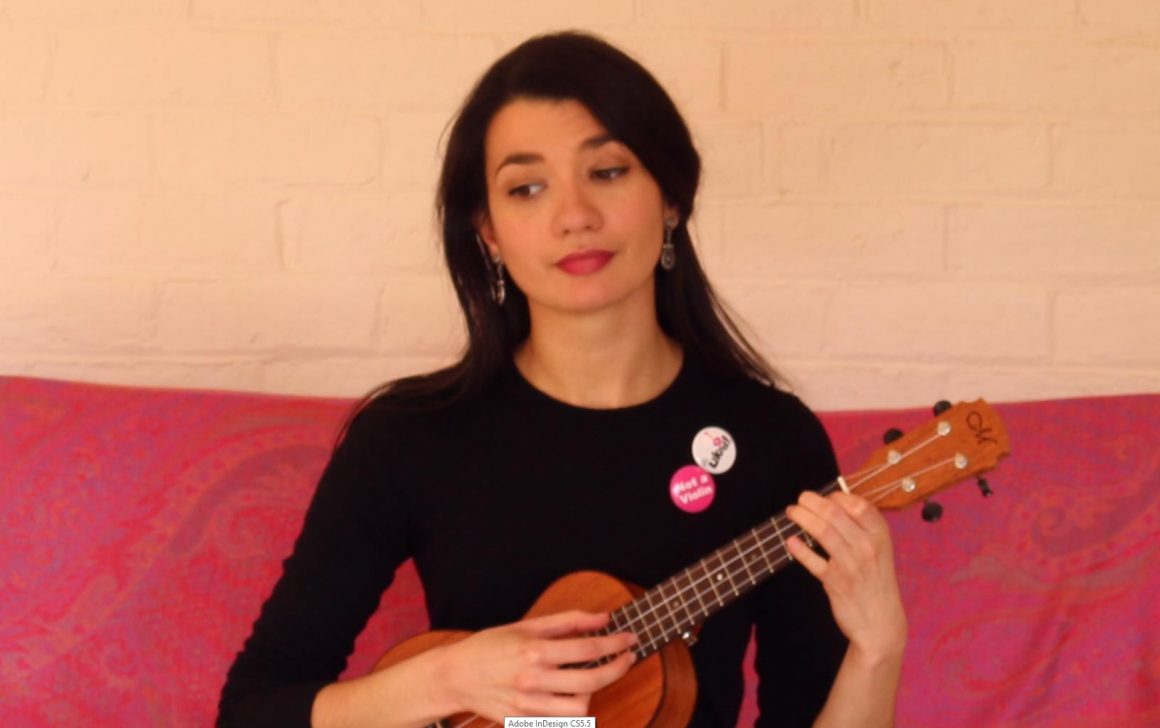Ever wanted to write your own song on your uke? Once you’ve mastered those familiar uke covers, you may recognise familiar chord patterns, beginnings and endings. You may also recognise familiar rhymes in the lyrics. You may feel inspired to write your own song, but worried about how to start.
I’m here to tell you that it’s possible to write a simple song even if your musical knowledge is fairly basic, like mine.
My first ukulele song was The Kooky Ukey Song, which later featured in Uked! – The first play-along ukulele musical. I was living in Singapore and had just begun learning the uke on YouTube. Like Karla I was in love, so this song was an ode to the ukulele.
I’d written a few musical theatre songs before, but song writing with my ukulele was much more fun.
Here is my seven-step guide to writing your first song on your ukulele
1. Have something to say
Writing is hard work, so it helps if you are compelled by your message. The Kooky Ukey Song, which Karla writes in Uked! was an ode to the versatility and joy of the ukulele, so each verse focuses on an aspect of that.
Hopeful Romantic was about Karla refuting her friend Julie’s claim that she was a hopeless romantic, and her dreams of finding her knight in shining armour. This song was cut from the show because I felt it was important to have familiar songs that the audience could play along with, but my daughter Greta recorded it later just for fun. Check it out below.
2. Write your lyrics
I’m a wordsmith, so I like to start with the lyrics. They don’t have to be perfect to start with. Just get those words on the page.
It helps to start with a title. Unlike a short story or novel, a song doesn’t need a climax or big reveal. It can just be about an emotion. But each verse needs to build on that and say something new.
Keep it simple and don’t worry about rhymes yet. Remember, these words will be sung, so don’t try to be too clever. Words that end in vowels such as ooh and ah or ee are easier to sing. Repetition is also good. It emphasis your central emotion and helps the song stick in people’s heads.
Sometimes it’s good to include a question. One of the most popular ukulele song covers, Can’t Help Falling in Love, written by Hugo Peretti, Luigi Creatore, and George David Weiss in 1961, and recorded by Elvis Presley, among others, asks: Shall I stay? Would it be a sin? – which is answered later with the line: Some things are meant to be.
3. Refine your rhymes
This is the fun part. Once you’ve got your basic story and emotion, look for the corresponding rhyming words. I used Rhymezone, an online rhyming dictionary. The huge range of suggestions may also give you more ideas for your lyrics. Link here.
4. Clap out your rhythm
Once you have a simple verse that you are happy with, repeat it aloud, clapping out the rhythm. Words have a natural rhythm of their own, depending on the number of syllables. Listening to these can help you find the tune. It helps to walk around the room while you do this. Even the common phrase, “How are you, today?” has a simple rhythm and pitch. Pair it with another simple phrase: “Please, come out and play?” and you have half a verse.
5. Find your melody
Once you have found the rhythm in your lyrics, experiment on your ukulele by picking out a tune on your fretboard one note at a time, while reciting the lyrics using that rhythm. You don’t have to know the notes on your fret board. Just have a go and listen to what comes up. Try playing a variation of a scale or a riff that you may know and sing along to that.
I sometimes try to pick out the tune on the piano (one hand – I’m no pianist), while I’m singing along. Don’t expect to get it right on your first go. Creativity is a meditative process. Go with the flow. You can also try messing around with a tune you already know and changing it. Vary the pitch and the rhythm to make your song interesting, saving your high notes for your big emotions. Don’t worry if it sounds crazy weird to begin with.
The first part of the tune should establish the tone and style. You can then vary it by adding a chorus and a bridge. I added Shave and Hair Cut, as illustrated by YouTube ukulele teacher Petey Forest, at the end of The Kooky Ukey Song, as a type of full stop.
Record your attempts by singing the tune into your phone or other recording device. It’s easier to record each section separately. Keep all attempts, no matter how corny. You may use all or only parts of them for this song later, or for another song.
6. Find your key
Once the basic tune is in your head and on your phone, find the matching chords on the uke by singing the tune while playing chords you are familiar with until you find ones that fit.
Keep the chord progressions simple to start with. Many a great country song has just three chords. The Kookey Ukey Song is just C, F and G. Hopeful Romantic is just E7, A and D. As Maestro says in the show: “For a happy song use major chords and for a sad song use minor chords.”
7. Record your first draft
Send your first draft to a trusted friend or mentor and ask for feedback. This will help you to discover whether your audience understands your intention and whether the melody and rhythm work together. All writing involves re-writing, so enjoy the process of creating a song that you are truly happy with.
My songs are very simple and could probably benefit from a real composer adding dynamics and variations, but they are fit for purpose, as like me Karla, our heroine in Uked! was just learning.
Let me know how you go. I’d love to hear your first song. You never know: like Karla, you might discover a hidden talent.


